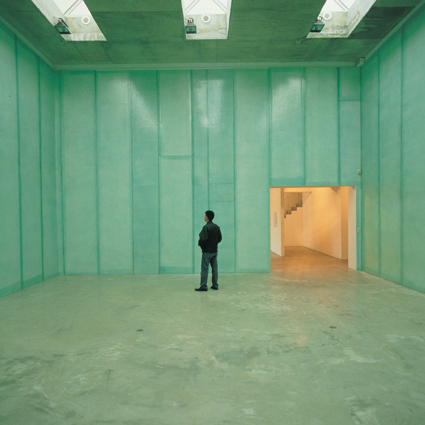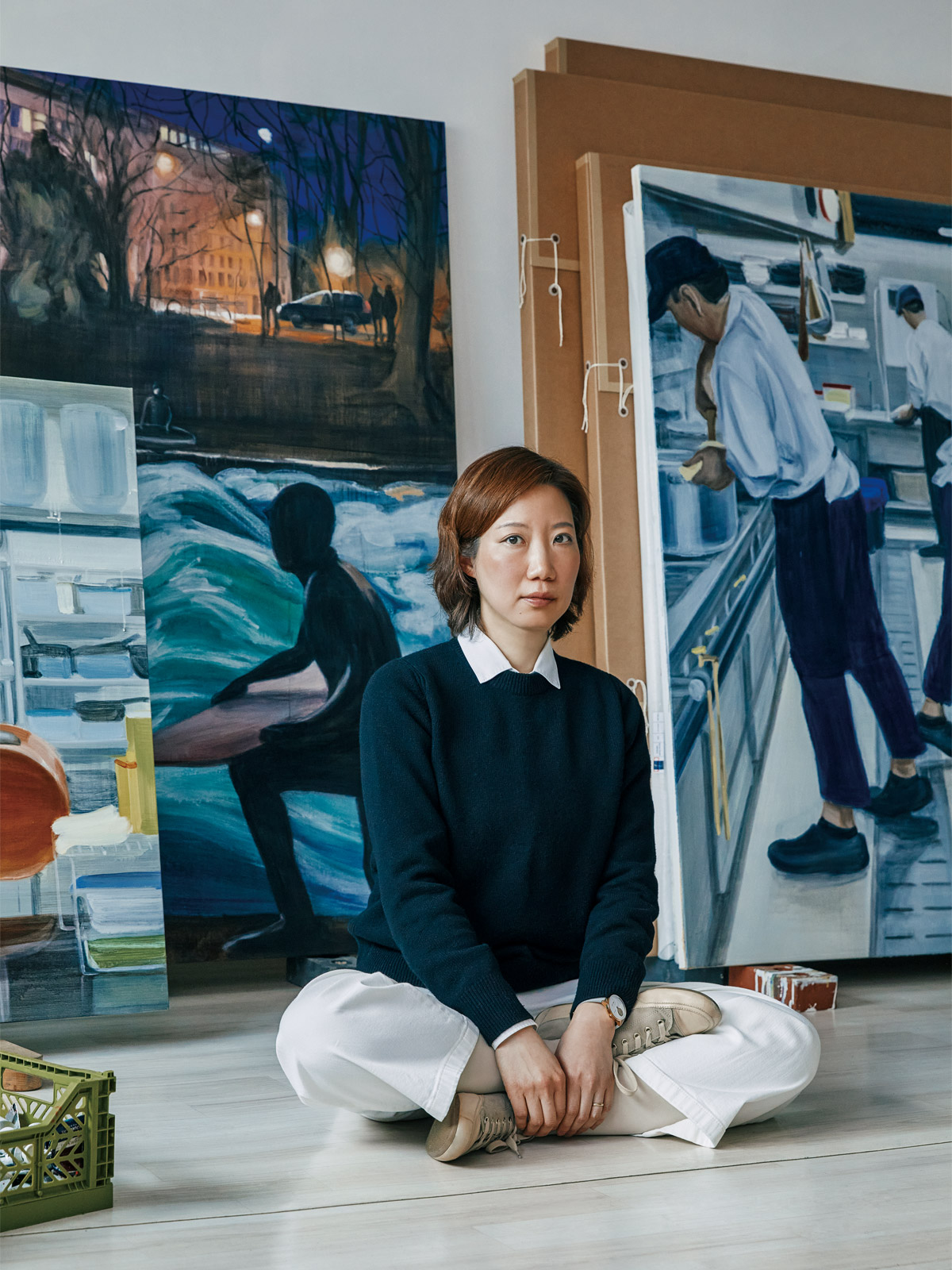Kiwon
Park (b. 1964) is an artist who has pioneered new horizons in Korean
contemporary installation art by crossing genre boundaries and developing a
distinctive body of work that refuses to conform to the times. His work is
known for large-scale installations that reinterpret space using a variety of
materials, including wire, transparent vinyl, air tubes, plastic mirrors, and
oil-painted sheets.
Since
winning the Grand Prize at the 13th Joongang Fine Arts Prize in 1990, Park has
consistently presented simple and material-focused works. From the mid-1990s, he
began to explore space and materials, earning recognition for his unique
artistic approach that not only redefines the existence of art but also offers
viewers new ways of experiencing his work.

Kiwon Park, Move, 1996 ©2004 Arts Council Korea
Kiwon Park's early work began with an
interest in the materiality of painting, and was characterized by minimalist
flat experiments that utilized various materials, such as plywood, to make use
of the material's unique characteristics. In 1996, the artist's interest in
this pure materiality began to expand into space.
His spatial installations start with a
personal feeling for the place. In the case of Move,
which was shown at Gaain Gallery in 1996, it started with the perception of a
certain movement in the blank walls of the space, which was felt in the long,
large surface area, even though there was nothing there.
As a result of thinking about how to
embody this movement on the walls of the exhibition space, the artist attached
thin, translucent, one-meter jade-colored FRP (a plastic mixed with polyester
resin and reinforcements such as fibers) boards in a row on the walls, creating
a new atmosphere without compromising the pure character of the space.
 Kiwon Park, Diminish,
2005 ©313 Art Project
Kiwon Park, Diminish,
2005 ©313 Art ProjectTranslucent jade-colored boards later appeared in his work Diminish (2005), which was exhibited at the Korean Pavilion at the Venice Biennale. Park transformed the Korean Pavilion at the Venice Biennale into a sculptural object by wrapping it in translucent jade-colored boards that blended with the surrounding landscape. These boards not only enveloped the building's exterior but also guided visitors through the interior, serving as a pathway. Additionally, other participating artists' works were displayed on these boards. This installation, titled Diminish, effectively highlighted the unique characteristics of the Korean Pavilion while connecting the entire exhibition, offering a compelling glimpse into contemporary Korean art.
 Kiwon Park, Light Weight,
2006 ©313 Art Project
Kiwon Park, Light Weight,
2006 ©313 Art ProjectThe following year, Park presented his installation Light Weight at the Museo Nacional Centro de Arte Reina Sofía in Madrid. The installation focused on the materiality of space, responding to the heavy, thick walls and stone floors of the museum. Park aimed to introduce a sense of lightness within this weighty environment by applying a light, transparent gel to the walls and laying soft, similarly colored tubes on the floor. This transformed the space into a comfortable and lightweight area where visitors could lie down and relax.
 Kiwon Park, Scenery,
2010 ©313 Art Project
Kiwon Park, Scenery,
2010 ©313 Art ProjectIn his solo exhibition “Who's Afraid
of Museums,” Kiwon Park, who was named the Artist of the Year 2010 by the
National Museum of Modern and Contemporary Art Korea (MMCA), presented three
works, Scenery, Dim, and Air Wall,
based on the space of the Gwacheon Building of the MMCA. Scenery began
by closely observing and measuring the 2,000 square meter concourse space of
the Gwacheon Building to capture the history of the space and its unique
atmosphere.
The artist attached
sheets of oil paint to the space one by one in order to preserve the unique
structure and atmosphere of the space while transforming the material of
granite, the museum's interior wall finish, into a turquoise jade stone. In
this way, Park's spatial work creates a new space that is both familiar and
unfamiliar, as if it belongs neither to the real nor to the unreal, with
minimal intervention. The work, the space in which it is placed, and the viewer
become part of the work.

Kiwon Park, Dialogue, 2022 ©Seoul Botanic Park
Park's
latest work, Dialogue (2022), takes as its
subject the place where the exhibition is held and the place identity. Dialogue is a
reinterpretation of the place of the Seoul Botanical Park, and is inspired by
the way visitors to the botanical park step on fallen leaves, inviting viewers
to walk through the exhibition by stepping on the imaginary leaves piled up on
the floor. As they walk over the work, which is composed of materials such as
copper and brass, Park suggests that they feel their movements and listen to
the sounds they make, creating an unspoken dialog with themselves.
Park
describes his work as a “conversation with empty space.” The artist has been
focusing on the history of space and its relationship with the surrounding
environment, aiming to create works that “breathe with the space.” And it is
only when the viewers enter and interact with the space that Kiwon Park’s work
is truly complete.
“It is the space itself which I consider the most significant in my artwork. Space, instead of being set as a backdrop, is equally important as the artwork. Hence I try to establish balance between the work and the space. I want the original environment or scenery to remain as it is. I just intend to create a minimum ‘action’ – like a subtle flow of air, or a wind softly brushing over the skin without being noticed, or an irretraceable impression of a passerby.” (From the artist’s statement)
 Artist Kiwon Park ©Noblesse
Artist Kiwon Park ©NoblesseKiwon
Park majored in Western painting at Chungbuk National University, Department of
Art Education. Park’s solo exhibitions include 313 Art Project, Seoul (2019,
2016); National Museum of Modern and Contemporary Art, Gwacheon (2010); Museo
Nacional Centro de Arte Reina Sofia, Madrid (2006); and ARKO Art Center (2006).
He has
also participated in group exhibitions including Suwon Museum of Art Art Space
Gwanggyo (2020); Cheongju Museum of Art (2019); OCI Museum (2018); National
Museum of Modern and Contemporary Art, Gwacheon (2016); Amorepacific Museum of
Art, Seoul (2016); Esprit Dior, DDP, Seoul (2015); Kumho Museum of Art, Seoul
(2015); Galleria Continua, Les Moulins, France (2014-15); East Side Gallery
Berlin, Berlin (2014); Busan Museum of Art, Busan (2013). In 2005, he was
selected as a participating artist in the Korean Pavilion at the 51st Venice
Biennale, and in 2000, he participated in a special exhibition at the Gwangju
Biennale.
References
- 313 Art Project, 박기원 (313 Art Project, Kiwon Park)
- 아라리오 갤러리, [수상] 박기원: 제36회 김세중조각상 (ARARIO Gallery, [Gallery] Park Kiwon: The 36th Kim Se-Choong Sculpture Award)
- 국립현대미술관, 올해의 작가 박기원 - 누가 미술관을 두려워하랴 (National Museum of Modern and Contemporary Art Korea, Artist of the Year 2010 Kiwon Park – Who’s Afraid of Museums?)
- 노블레스, 박기원의 붉은 방, 2019.06.25
- 서울식물관, 대화 (Seoul Botanic Park, Dialogue)



















